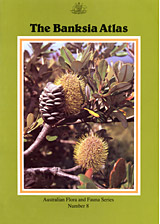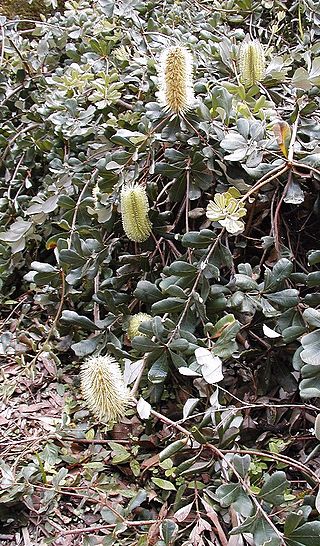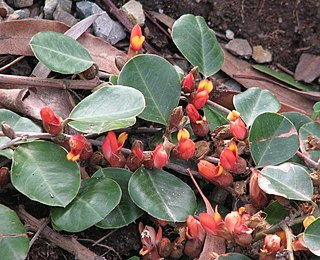
Banksia is a genus of around 170 species in the plant family Proteaceae. These Australian wildflowers and popular garden plants are easily recognised by their characteristic flower spikes, and fruiting "cones" and heads. Banksias range in size from prostrate woody shrubs to trees up to 30 metres tall. They are found in a wide variety of landscapes: sclerophyll forest, (occasionally) rainforest, shrubland, and some more arid landscapes, though not in Australia's deserts.

Phalangeriformes is a paraphyletic suborder of about 70 species of small to medium-sized arboreal marsupials native to Australia, New Guinea, and Sulawesi. The species are commonly known as possums, gliders, and cuscus. The common name "possum" for various Phalangeriformes species derives from the creatures' resemblance to the opossums of the Americas. However, although opossums are also marsupials, Australasian possums are more closely related to other Australasian marsupials such as kangaroos.

The mountain pygmy possum ; also simply known as the burramys, is a small, mouse-sized nocturnal marsupial of Australia found in dense alpine rock screes and boulder fields, mainly southern Victoria and around Mount Kosciuszko in Kosciuszko National Park in New South Wales at elevations from 1,300 to 2,230 metres. At almost 14 cm (5.5 in), its prehensile tail is longer than its 11 cm (4.3 in) combined head and body length. Its diet consists of insects, fleshy fruits, nuts, nectar and seeds. Its body is covered in a thick coat of fine grey fur except for its stomach, which is cream coloured; its tail is hairless. On the underside of the female's body is a pouch containing four teats. This possum is the only extant species in the genus Burramys. It is also the only Australian mammal restricted to alpine habitat.

The Tasmanian pygmy possum, also known as the little pygmy possum or tiny pygmy possum, is the world's smallest possum. It was first described by Oldfield Thomas in 1888, after he identified that a museum specimen labelled as an eastern pygmy possum in fact represented a species then unknown to science. The holotype resides in the Natural History Museum in London.

Pseudocheiridae is a family of arboreal marsupials containing 17 extant species of ringtailed possums and close relatives. They are found in forested areas and shrublands throughout Australia and New Guinea.

Banksia serrata, commonly known as the saw banksia, the old man banksia, the saw-tooth banksia or the red honeysuckle and as wiriyagan by the Cadigal people, is a species of woody shrub or tree of the genus Banksia, in the family Proteaceae. Native to the east coast of Australia, it is found from Queensland to Victoria with outlying populations on Tasmania and Flinders Island. Commonly growing as a gnarled tree up to 16 m (50 ft) in height, it can be much smaller in more exposed areas. This Banksia species has wrinkled grey bark, shiny dark green serrated leaves and large yellow or greyish-yellow flower spikes appearing over summer. The flower spikes, or inflorescences, turn grey as they age and pollinated flowers develop into large, grey, woody seed pods called follicles.

The pygmy possums are a family of small possums that together form the marsupial family Burramyidae. The five extant species of pygmy possum are grouped into two genera. Four of the species are endemic to Australia, with one species also co-occurring in Papua New Guinea and Indonesia.

Banksia ericifolia, the heath-leaved banksia, or lantern banksia, is a species of woody shrub of the family Proteaceae native to Australia. It grows in two separate regions of Central and Northern New South Wales east of the Great Dividing Range. Well known for its orange or red autumn inflorescences, which contrast with its green fine-leaved heath-like foliage, it is a medium to large shrub that can reach 6 m (20 ft) high and wide, though is usually half that size. In exposed heathlands and coastal areas, it is more often 1–2 m (3.3–6.6 ft).

Banksia spinulosa, the hairpin banksia, is a species of woody shrub, of the genus Banksia in the family Proteaceae, native to eastern Australia. Widely distributed, it is found as an understorey plant in open dry forest or heathland from Victoria to northern Queensland, generally on sandstone though sometimes also clay soils. It generally grows as a small shrub to 2 metres (7 ft) in height, though can be a straggly tree to 6 metres (20 ft). It has long narrow leaves with inflorescences which can vary considerably in coloration; while the spikes are gold or less commonly yellowish, the emergent styles may be a wide range of colours – from black, purple, red, orange or yellow.

Banksia aemula, commonly known as the wallum banksia, is a shrub of the family Proteaceae. Found from Bundaberg south to Sydney on the Australian east coast, it is encountered as a shrub or a tree to 8 m (26 ft) in coastal heath on deep sandy soil, known as Wallum. It has wrinkled orange bark and shiny green serrated leaves, with green-yellow flower spikes, known as inflorescences, appearing in autumn. The flower spikes turn grey as they age and large grey follicles appear. Banksia aemula resprouts from its woody base, known as a lignotuber, after bushfires.

The Banksia Atlas is an atlas that documents the ranges, habitats and growth forms of various species and other subgeneric taxa of Banksia, an iconic Australian wildflower genus. First published in 1988, it was the result of a three-year nationwide program involving over 400 amateur and professional volunteers.

Celia Elizabeth Rosser is an Australian botanical illustrator, best known for having published The Banksias, a three-volume series of monographs containing watercolour paintings of every Banksia species.

The eastern pygmy possum is a diprotodont marsupial of south-eastern Australia. Occurring from southern Queensland to eastern South Australia and also Tasmania, it is found in a range of habitats, including rainforest, sclerophyll forest, woodland and heath.

Banksia 'Roller Coaster', sometimes referred to as Banksia 'Austraflora Roller Coaster', is a registered Banksia cultivar bred from Banksia integrifolia subsp. integrifolia. Its extended cultivar name is Banksia integrifolia 'Roller Coaster'. It was bred, propagated and promoted by horticulturist Bill Molyneux of Austraflora nursery in Victoria, Australia. Chosen and bred for its vigorous prostrate habit, this has become a popular plant in both private and public gardens in eastern Australia, particularly Sydney and Melbourne.
Banksia 'Superman', also known by its extended cultivar name Banksia serrata 'Superman', is a registered Banksia cultivar. It was discovered by Maria Hitchcock of Armidale NSW near Nambucca in 1986 during the Banksia Atlas project. An attempt to have it accorded subspecies rank was not successful so she named it 'Superman' to describe the giant inflorescences and leaves and in keeping with the common name for Banksia serrata. Its leaves and inflorescences are mostly twice the size of typical plants of its parent species, Banksia serrata. Naturally occurring close to running water or on poorly drained sites between Nambucca Heads and Grassy Head in New South Wales, it grows true to seed.

The western pygmy possum, also known as the southwestern pygmy possum or the mundarda, is a small marsupial found in Australia. Genetic studies indicate its closest relative is probably the eastern pygmy possum, from which its ancestors diverged around eight million years ago.

The genus Cercartetus is a group of very small possums known as pygmy possums. Four species comprise this genus, which together with the genus Burramys make up the marsupial family Burramyidae.

Banksia 'Birthday Candles' is a dwarf cultivar of Banksia spinulosa var. spinulosa developed by Bill Molyneux of Austraflora Nurseries in Montrose, Victoria. It has since become the highest-selling native plant in Australia.
Yarrabee Wesfarmers Reserve is a 9.23 km2 nature reserve in south-west Western Australia. It is 120 km north-east of Albany and 481 km south-east of Perth. It lies on the eastern boundary of the Stirling Range National Park, and is managed by Bush Heritage Australia (BHA), by which it was purchased in 2006 with the financial assistance of Wesfarmers. It is jointly owned by BHA and by Greening Australia (WA), and forms part of BHA's Gondwana Link project.

A prostrate shrub is a woody plant, most of the branches of which lie upon or just above the ground, rather than being held erect as are the branches of most trees and shrubs.
















